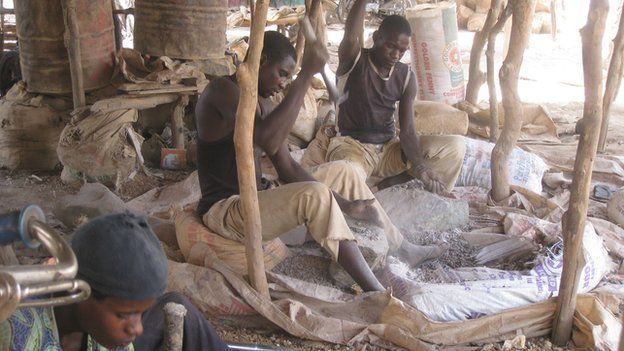Cleaning up Nigeria’s toxic playgrounds
- Published

In a remote region of northern Nigeria the signs of a lead poisoning crisis caused by small-scale gold mining are still visible especially among children, despite a four-year clean-up project.
Four-year-old Umaima stares into space, seeming detached from all that is going on around her in the small village of Sumke.
She has not been able to talk or hear since she was two. For some months she was unable to walk until she received medical treatment.
"I feel lucky, because a child next door died of the same illness," her mother says.
The contamination in Nigeria's Zamfara state is seen as the worst case of lead poisoning in the world.
More than 460 children have died since 2009, and the health of thousands has been affected.
The lead is a deadly by-product of the small-scale gold mining industry in Zamfara.
The government says the mining is illegal, but in this rural Muslim region of north-western Nigeria it has been going on for generations - and it was a discovery of greater deposits that has led to the recent boom in digging for gold.
Dangerous work
At the Darata gold mine, a group of men gather around several deep dark pits, waiting for their colleagues who are several dozen feet under the ground hacking away at the rock.
It is dangerous work and some are down the pits for several days at a time.
"I'm never going to stop this work because it's the only way I can earn a living around here," says one of the miners as he emerges from a deep pit.
"I know some people have died from poisoning, but not from my family and even if anything were to happen it would be a sign of God's will," he tells me.
Village dust
The sacks of rock which are brought up from underground are carried on the backs of motorbikes to a nearby processing site.
Here dozens of men and young boys work under the 45C (113F) heat hammering rocks, operating grinding machines and sifting for gold.
The danger is in the dust. It is full of toxic lead, and is carried to the workers' homes on their clothes and tools.
Most at risk are the children because the dust turns their villages into a poisonous playground.
Their young bodies are vulnerable to the effects of the toxins.
This crisis began in 2009. The government has not stopped the activity, though it says it will introduce safer mining practices - which are yet to be seen on the ground.
President Goodluck Jonathan pledged $4m (£2.6m) in May 2012, however, the money was not released until January.
It took an online and media campaign by local and international organisations to get the funds released.
Mercy Abang, a journalist and activist from Citizens Platform, was part of that drive, and says it is not enough for the money to be released but it also has to be used appropriately.
"It's not news that we have a history of misappropriation of funds in Nigeria," she says.
"The money has to pass through several stages to get down, and it is necessary for us to follow the money at each stage."
Bagega village is the last of the eight affected communities to be cleaned up over the last four years.
Using shovels, workers dig up and remove all the contaminated soil and replace it with clean earth - in some cases the walls of these mud buildings have to be plastered afresh.
It is a painfully slow process, and is not helped by the fact that the equipment promised by the government has not arrived.
No children in this village can be treated for the effects of the poisoning until this clean-up is completed.
Long-term fears
In Sumke village, where the toxic soil has been removed, the medical charity Medecins Sans Frontiers (MSF) runs a treatment clinic where mothers bring their affected children to receive medicine.
It is a complicated, drawn out process, which for some children could last up to 15 years.
But the aid agencies will not stay that long.
MSF's Zackaria Mwatia worries that the government might not be able to take over from them.
"The main challenge we face is we don't see [the] federal ministry of health on the ground," he says.
"We would like them to send the doctors, the nurses, the laboratory scientists so that we build their capacity.
"They would have built their skills and they will be able to handle this programme successfully."
Health Minister Dr Muhammed Pate said MSF had no reason to worry.
"This is a man-made disaster; it is not a natural disaster - illegal mining is the underlying reason for this lack of awareness is behind it," he says.
"We can't sit behind and… not take action. Government will continue to take all steps to protect the lives and well being of its people."
But as the blame is traded, thousands of children in these villages face a difficult future.
As the mining continues it is they who will pay a high price.
- Published29 January 2013
- Published10 June 2010
- Published5 October 2010
- Published22 September 2010